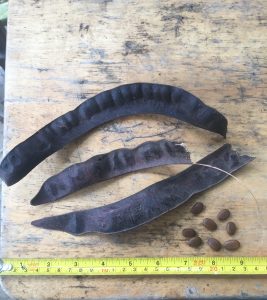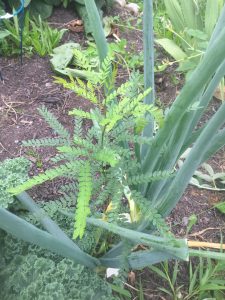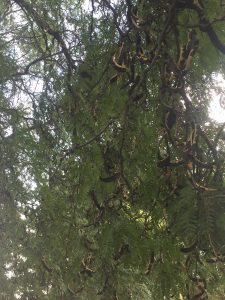(Gleditsia triacanthos)

 Description
Description
Honey Locust is a fast-growing leguminous tree that can grow up to 100 feet tall and lives 100-150 years. It has pinnate compound leaves and produces long seed pods in the summer that mature in late September to early October. Some varieties contain thorns.
Cultivation Tips
Honey Locust is a rapid grower that will tolerate harsh conditions. It will thrive even in poor, compacted soils low in nitrogen, and can tolerate high salinity, making them ideal for roadside use. Honey locust can also tolerate heat and drought relatively well. Honey Locust can be pollarded or coppiced and will re-sprout vigorously from the stump, making it useful for a roadside hedge row or as a nurse plant. Seeds from the honey locust are encased in a hard shell that must be scarified prior to germination. Make a small score with a file or sand paper until the inner seed is visible through the shell, then place in water. When the seeds have swollen to 2-3 times their initial size they are ready for planting in a loose, moist soil. If planting in pots, be sure to use deep enough pots to allow the taproot to grow freely. Seeds can also be direct sown in the garden, with or without scarificaiton, but unscarified seeds may need several freeze-thaw cycles to germinate, potentially taking a few years.

Uses
The seeds of honey locust are edible, and can be ground into a flour. Seed pods are ripe when they are dark brown/maroon and rattle like a maraca when shaken. The pulp within the seed pods can also be eaten and is very sweet, hence the name honey locust. The pulp is sweetest and most abundant when the pods are still slightly green. Honey locusts are nitrogen fixers that will fertilize the soil for plants around it. Coppicing and pollarding can allow for yields of high quality timber and dowels that are very dense and rot resistant. The indigenous people of Lenapehoking would boil the bark of the honey locust in order to induce perspiration as a treatment for colds [109].

Friends
Honey Locust gets along very well with others. It makes a great companion to heavy nitrogen feeders, like nuts and leafy greens, and its pinnately compound leaves means it won’t excessively shade out plants in the understory.